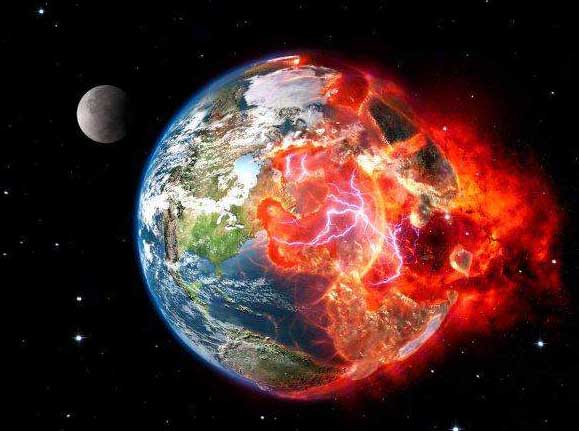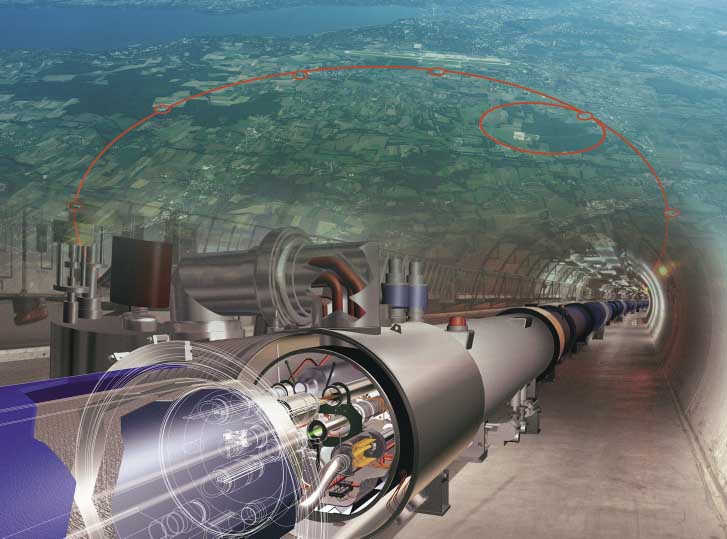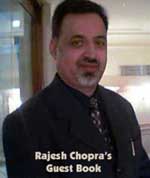 |
 |
|
|
Purpose
The LHC is the world's largest and the highest-energy particle accelerator.It is funded and built in collaboration with over eight thousand physicists from over eighty-five countries as well as hundreds of universities and laboratories. The collider is currently undergoing commissioning while being cooled down to its final operating temperature of approximately 1.9 K (?271.25 °C). Initial particle beam injections were successfully carried out on 8-11 August 2008, the first attempt to circulate a beam through the entire LHC is scheduled for 10 September 2008, and the first high-energy collisions are planned to take place after the LHC is officially unveiled, on 21 October 2008. When activated, it is theorized that the collider will produce the elusive Higgs boson, the observation of which could confirm the predictions and missing links in the Standard Model of physics and could explain how other elementary particles acquire properties such as mass. Although a few individuals have questioned the safety of the planned experiments in the media and through the courts, the consensus in the scientific community is that there is no basis for any conceivable threat from the LHC particle collisions. The idea of the Large Hadron Collider (LHC), began in the early 1980s. The first approval of the project by the European Organization for Nuclear Research (CERN) Council occurred in December 1994 and the first civil engineering construction work began in April 1998. It is funded and built in collaboration with over eight thousand physicists from over eighty-five countries as well as hundreds of universities and laboratories. The LHC is the world's largest and the highest-energy particle accelerator. The collider is contained in a circular tunnel with a circumference of 27 kilometres (17 mi) at a depth ranging from 50 to 175 metres underground. The 3.8 metre diameter, concrete-lined tunnel, constructed between 1983 and 1988, was formerly used to house the LEP, an electron-positron collider. It crosses the border between Switzerland and France at four points, although most of it is in France. Surface buildings hold ancillary equipment such as compressors, ventilation equipment, control electronics and refrigeration plants. The collider tunnel contains two adjacent beam pipes, each containing a proton beam (a proton is one type of hadron). The two beams travel in opposite directions around the ring. Some 1,232 bending magnets keep the beams on their circular path, while an additional 392 focusing magnets are used to keep the beams focused, in order to maximize the chances of interaction between the particles in the four intersection points, where the two beams will cross. In total, over 1,600 superconducting magnets are installed, with most weighing over 27 tonnes. Approximately 96 tonnes of liquid helium is needed to keep the magnets at the operating temperature (1.9K), making the LHC the largest cryogenic facility in the world at liquid helium temperature. Once or twice a day, as the protons are accelerated from 450 GeV to 7 TeV, the field of the superconducting bending magnets will be increased from 0.54 T to 8.3 T. The protons will each have an energy of 7 TeV, giving a total collision energy of 14 TeV. It will take less than 90 microseconds for a proton to travel once around the main ring (a speed of about 11,000 revolutions per second). Rather than continuous beams, the protons will be bunched together, into 2,808 bunches, so that interactions between the two beams will take place at discrete intervals never shorter than 25 ns apart. When the collider is first commissioned, it will be operated with fewer bunches, to give a bunch crossing interval of 75 ns. The number of bunches will later be increased to give a final bunch crossing interval of 25 ns The total cost of the project
is anticipated to be between €3.2 to €6.4 billion. The construction
of LHC was approved in 1995 with a budget of 2.6 billion Swiss francs (€1.6
billion), with another 210 million francs (€140 million) towards the
cost of the experiments. However, cost over-runs, estimated in a major
review in 2001 at around 480 million francs (€300 million) for the
accelerator, and 50 million francs (€30 million) for the experiments,
along with a reduction in CERN's budget, pushed the completion date from
2005 to April 2007. 180 million francs (€120 million) of the cost
increase have been due to the superconducting magnets. There were also
engineering difficulties encountered while building the underground cavern
for the Compact Muon Solenoid. In part this was due to faulty parts lent
to CERN by fellow laboratories Argonne National Laboratory or Fermilab).
 Dr Lyn Evans, who has been
dubbed Evans the Atom, will this week switch on a giant particle accelerator
designed to unlock the secrets of the Big Bang.
I was more interested in chemistry than physics when I was young,’ he said. ‘I had a number of chemistry sets. Like everybody, I used to make explosives. I even blew the fuses of the whole house a few times.’ His interest in physics grew at his boys-only grammar school, where lessons had an added attraction because they were attended by girls bussed in from a nearby school that lacked a physics teacher. On Wednesday, Dr Evans will fire up the Large Hadron Collider, a 17-mile-long doughnut-shaped tunnel that will smash sub-atomic particles together at nearly the speed of light. Built by the European Organisation for Nuclear Research (CERN), the collider lies beneath the French-Swiss border, near the institution’s headquarters in Geneva, at depths ranging from 170ft to 600ft. The aim of the £4.4billion experiment is to recreate the conditions that existed a fraction of a second after the Big Bang – the birth of the universe – and provide vital clues to the building blocks of life. It will track the spray of particles thrown out by collisions in a search for the elusive Higgs Boson, a theoretical entity that supposedly lends weight, or mass, to the elementary particles. So important is this mysterious substance that it has been called the ‘God Particle’. Scientists also hope to shed some light on the invisible material that exists between particles – dubbed ‘dark matter’ as no one knows what it really is – which makes up most of the universe. But a handful of scientists believe that the experiment could create a shower of unstable black holes that could ‘eat’ the planet from within, and they are launching last-ditch efforts to halt it in the courts. One of them, Professor Otto Rossler, a retired German chemist, said he feared the experiment may create a devastating quasar – a mass of energy fuelled by black holes – inside the Earth. ‘Nothing will happen for at least four years,’ he said. ‘Then someone will spot a light ray coming out of the Indian Ocean during the night and no one will be able to explain it. ‘A few weeks later, we will see a similar beam of particles coming out of the soil on the other side of the planet. Then we will know there is a little quasar inside the planet.’ Prof Rossler said that as the spinning-top-like quasar devoured the world from within, the two jets emanating from it would grow and catastrophes such as earthquakes and tsunamis would occur at the points they emerged from the Earth. ‘The weather will change completely, wiping out life, and very soon the whole planet will be eaten in a magnificent scenario – if you could watch it from the moon. A Biblical Armageddon. Even cloud and fire will form, as it says in the Bible.’ He said that attempts were still being made in the European Court of Human Rights to halt the experiment on the grounds that it violated the right to life. The court has, however, already rejected calls for a temporary delay in the project, and it is unlikely to come to a speedy decision about whether the CERN experiment should be halted for good. Meanwhile Dr Walter Wagner, an American scientist who has been warning about the dangers of particle accelerators for 20 years, is awaiting a ruling on a lawsuit he filed a fortnight ago in his home state of Hawaii. He fears the experiments might unwittingly create something he calls a ‘strangelet’ that could result in a fusion reaction that might ultimately turn the Earth into a supernova, or an exploding star.
‘We are not used to that. We are used to setting things up quietly and announcing it afterwards.’ Experiment produces lab rap
hit
Written and performed by 23-year-old Kate McAlpine, who works in the Press office at the CERN laboratory in Switzerland, the video features Kate and two background dancers bopping about in lab coats. A long way from rap’s usual subjects of violence and crime, the rap focuses on the science of high-energy particle physics. One section goes: ‘Two beams of protons/ swing ’round./ Through the ring they ride/’til in the hearts of the detectors/ they’re made to collide!/ And all that energy packed/ in that tiny room/ becomes mass,/ particles created from the vacuum.’ Kate, who wrote her first physics rap while studying at Michigan State University, says: ‘Rap and physics are culturally miles apart and I find it amusing to throw them together.’ A CERN spokesman said: ‘We love the rap and the science is spot on.’ Nostradamus
predict the Large Hadron Collider
|

 |
 |
 |
|
LiveIndia.Com Copyright
© 1998-2001 Live India Internet Services! All rights reserved
|